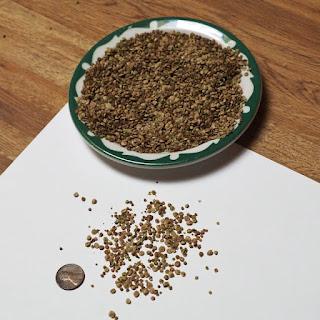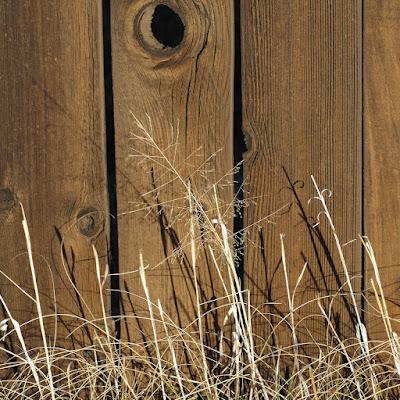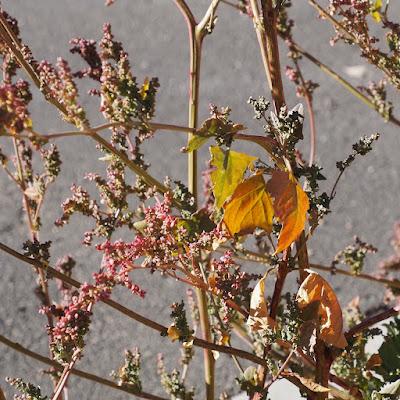
A strip of bare soil six feet wide was left between the sidewalk and street—reputedly called a parkway in Wyoming. One day Ben Huhnke, the general contractor, asked what I'd like in my parkway (he actually said "there" and pointed). I replied "native grass" and he said "ok".
Several months later a subcontractor spread seed mix on the parkway. Ben stopped by again and told me they put down "prairie grass". I said "great".
This past summer (2023) was exceptionally wet. The plants loved it! And Ben was right. Prairie Saltgrass, native to the Laramie Basin, filled in much of the parkway. Several nice stands of Foxtail Barley appeared, along with one of my favorite grasses, Alkali Sacaton, and some Western Wheatgrass (these may have arrived on their own from the prairie nearby). There were small bunch grasses I didn't recognize, perhaps cultivars for landscaping. I will learn more next year.
Prairie grasses in autumn:
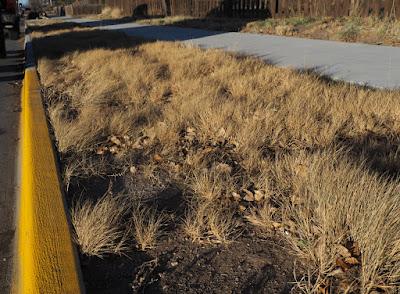
Distichlis spicata, Prairie or Inland Saltgrass.
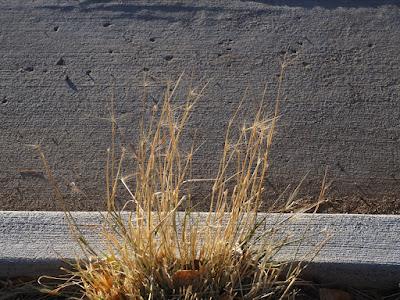
Hordeum jubatum, Foxtail Barley.
Sporobolus airoides, Alkali Sacaton.
Even with all this grass there still was plenty of bare dirt. Colonizing annuals moved in, as was to be expected. But a big surprise showed up on the corner—about 35 annuals to six feet in height!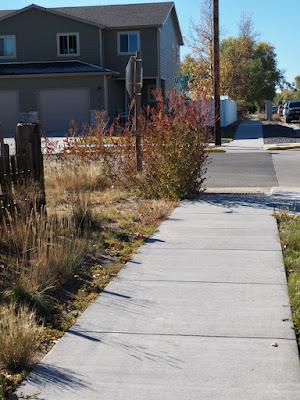
My sidewalk leading to the stand of large mystery plants.
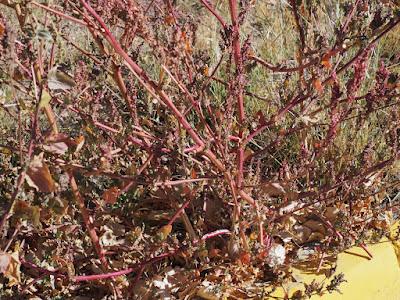
Stout reddish stems and branches (they were yellowish green early in the season).
Autumn leaves.
The leaves suggested lambsquarters (genus Chenopodium), but none of the species I know grow so tall. Then a vague memory surfaced, from my review of South Dakota chenopods and amaranths. Could this be one of the larger annual orachs (genus Atriplex) with dimorphic female flowers? The Flora of North America, with the help of DuckDuckGo (I've switched), confirmed my suspicions. But which one? That was not clear.If I had to pick I'd choose A. heterosperma, the Russian Orach, as I found no ebracteolate flowers (botany geeks, see (1) in Notes below). But maybe they fell off. And the plants were red and huge, more like A. hortensis, the French Orach. I couldn't decide. No matter, they're both edible (2).
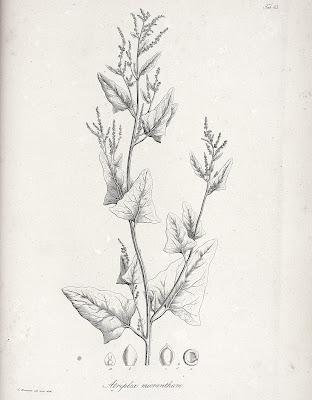
Atriplex heterosperma (formerly A. micranthum) is native from Europe east to Chinese Turkestan. From "Icons of new or incompletely known plants illustrating the Russian flora, especially the Altaic" (Google's translation from Latin), 1829–34. BHL.

Atriplex hortensis (formerly Chenopodium hortense) is native to western Asia and the Mediterranean region. Jacob Sturm painting, 1796. Source.
Orachs (Atriplex), lambsquarters (Chenopodium), and domesticated spinach (Spinacia) are all in the same family—the Chenopodiaceae (recently combined into the Amaranthaceae). Their leaves generally are edible or at least not toxic, and often taste slightly salty. Tastiness varies with species and age.A. hortensis, often called French Spinach, is used as a substitute for cultivated spinach. I recently learned that A. heterosperma, the Russian Orach, can be used that way as well. Wild Food Girl raves about orachs in general, and notes that A. heterosperma can be harvested guilt free because it's non-native. She recommends it for Wild Spring Salad, along with tumblemustard and salsify stems. I'm in luck! Both tumblemustard and meadow salsify showed up this year. Fingers crossed for another rainy summer, and productive foodscaping on the parkway.
Notes
(1) Like other members of the genus Atriplex, A. heterosperma and A. hortensis have small inconspicuous flowers and fruits, and the flowers are unisexual, either male or female. But these two species are unusual in that they have dimorphic female flowers (two kinds). In A. heterosperma some flowers produce large seeds, while others produce much smaller ones (i.e., hetero-sperma). In A. hortensis the flowers themselves differ. Many (most?) are enclosed in a pair of bracteoles, lack sepals, and hold their seeds vertically. Others are ebracteolate, do have sepals, and hold their seeds horizontally.
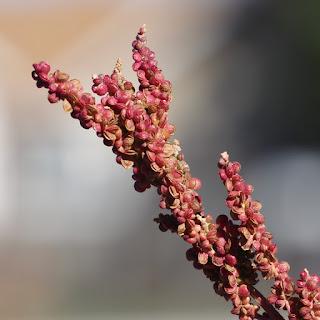
See any ebracteolate flowers?
(2) We are advised to harvest orach leaves from young plants, taking the tops and leaving older lower leaves for continued growth. Being a botanist I waited for flowers and fruits, hoping for confident identification. By that time the plants were robust, their leaves too tough to eat. But I have lots of seeds for next year.